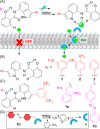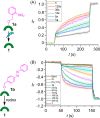Off-On Photo- and Redox-Triggered Anion Transport Using an Indole-Based Hydrogen Bond Switch
- PMID: 39554452
- PMCID: PMC11561614
- DOI: 10.1021/acsomega.4c07880
Off-On Photo- and Redox-Triggered Anion Transport Using an Indole-Based Hydrogen Bond Switch
Abstract
A stimulus-responsive indole-based hydrogen bonding switch is reported, which enables off-on activation of transmembrane ion transport in response to photo- and redox triggers. This is achieved by alkylation of an indole-based anionophore, preorganized through intramolecular hydrogen bonding, with o-nitrobenzyl and azobenzene cages. This renders the anionophore inactive through formation of a six-membered intramolecular hydrogen bonding interaction and locking of the anion binding protons. Decaging with biologically relevant light and redox stimuli leads to efficient activation of anion transport across lipid bilayer membranes by unlocking the hydrogen bond donors, such that they are now available for anion binding and transport.
© 2024 The Authors. Published by American Chemical Society.
Conflict of interest statement
The authors declare no competing financial interest.
Figures






Similar articles
-
Responsive Anionophores with AND Logic Multi-Stimuli Activation.Angew Chem Int Ed Engl. 2024 May 27;63(22):e202403314. doi: 10.1002/anie.202403314. Epub 2024 Apr 11. Angew Chem Int Ed Engl. 2024. PMID: 38517056
-
Stimuli-responsive anion transport utilising caged hydrazone-based anionophores.Nanoscale. 2024 Nov 28;16(46):21545-21553. doi: 10.1039/d4nr03220a. Nanoscale. 2024. PMID: 39480659
-
Transmembrane anion transport mediated by halogen bonding and hydrogen bonding triazole anionophores.Chem Sci. 2020 Apr 15;11(18):4722-4729. doi: 10.1039/d0sc01467b. Chem Sci. 2020. PMID: 34122927 Free PMC article.
-
Anion transport with halogen bonds.Top Curr Chem. 2015;358:205-39. doi: 10.1007/128_2014_541. Top Curr Chem. 2015. PMID: 24696354 Review.
-
Photo- and Redox-Regulated Transmembrane Ion Transporters.Angew Chem Int Ed Engl. 2023 Oct 26;62(44):e202308842. doi: 10.1002/anie.202308842. Epub 2023 Aug 3. Angew Chem Int Ed Engl. 2023. PMID: 37478126 Review.
Cited by
-
Resonsive anion transport with a Hamilton receptor-based anionophore controlled by photo-activation and host-guest competitive inhibition.Chem Sci. 2025 Jun 25;16(30):13715-13722. doi: 10.1039/d5sc02619a. eCollection 2025 Jul 30. Chem Sci. 2025. PMID: 40607051 Free PMC article.
References
-
- Manuel-Manresa P.; Korrodi-Gregório L.; Hernando E.; Villanueva A.; Martínez-García D.; Rodilla A. M.; Ramos R.; Fardilha M.; Moya J.; Quesada R.; Soto-Cerrato V.; Pérez-Tomás R. Novel Indole-based Tambjamine-Analogues Induce Apoptotic Lung Cancer Cell Death through p38 Mitogen-Activated Protein Kinase Activation. Mol. Cancer Ther. 2017, 16, 1224–1235. 10.1158/1535-7163.MCT-16-0752. - DOI - PubMed
LinkOut - more resources
Full Text Sources
